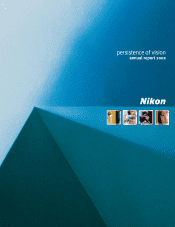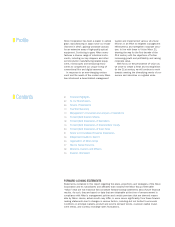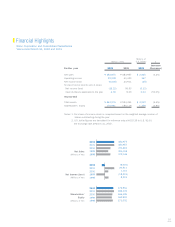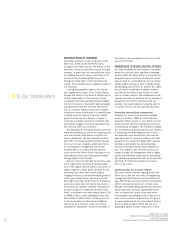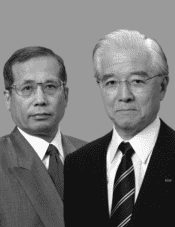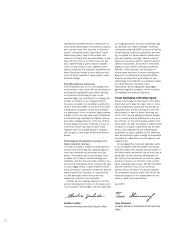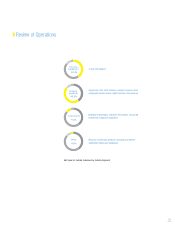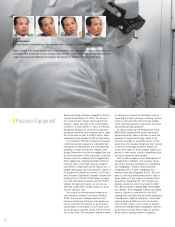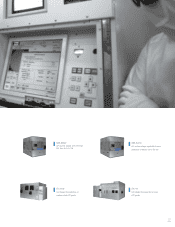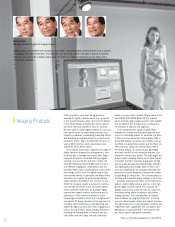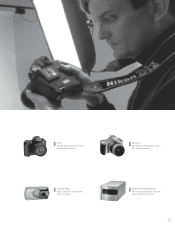Nikon 2002 Annual Report Download - page 4
Download and view the complete annual report
Please find page 4 of the 2002 Nikon annual report below. You can navigate through the pages in the report by either clicking on the pages listed below, or by using the keyword search tool below to find specific information within the annual report.
02
BUSINESS RESULTS OVERVIEW
Operating conditions in the fiscal year ended
March 31, 2002 proved extremely harsh
throughout the Nikon Group. The effects of the
economic downturn intensified across all major
markets. In particular, the semiconductor indus-
try suffered the most severe contraction in its
history as the IT-related global slump fed
through to steep falls in chip manufacturing
output. This inevitably had a negative impact on
our business.
Looking at geographic regions, the picture
was slightly more varied. In the United States,
despite the shock of the terrorist attacks and a
further deterioration in the economy, strong
underlying consumer spending helped mitigate
the fall in business investment. Signs emerged
during the year that the economy had hit bot-
tom. In contrast, falling exports and a capital
investment slump contributed to a steadily dete-
riorating economic picture in Europe. Overall
growth in Asia was also dented. In Japan, a
sharp fall in capital investment combined with
persistently sluggish consumer spending to tip
the economy back into recession.
We responded to the harsh business environ-
ment by redoubling our focus on supplying prod-
ucts and services that deliver complete cus-
tomer satisfaction. We also devoted consider-
able effort to entrenching the benefits derived
from our in-house company system and focus
on consolidated management. We further
boosted efforts to slash fixed and variable
costs across the Nikon Group, focusing on cut-
ting inventory levels and reducing receivables
through tighter credit control.
Results varied considerably by business seg-
ment. Against the backdrop of steady expan-
sion in the digital camera market, the launch of
digital single-lens reflex (SLR) cameras for pro-
fessionals and other new models helped
Imaging Products to achieve favorable growth in
sales, gain market share, and post consider-
ably higher earnings. Both Precision Equipment
and Instruments were hit hard by the slump in
semiconductor markets, however. Although the
positive impact of a weak yen provided some
relief, consolidated net sales edged down 0.2%
to ¥483.0 billion, while operating income tum-
bled 63.8% to ¥22.2 billion. Partly as a result
of the amortization of transitional obligation
that arose as a result of a new accounting
standard for employees’ retirement benefits in
the previous year, we posted a net loss for the
year of ¥6.0 billion.
PERSISTENCE OF VISION, SPECIFIC ACTIONS
As vividly illustrated by the conditions we experi-
enced this year, the most significant challenge
we face within the Nikon Group is recasting and
strengthening our business structure and profit
base so that, as a manufacturer, we can deliver
strong, stable earnings in such a rapidly chang-
ing operating environment. To achieve this objec-
tive we need to implement a variety of meas-
ures across the Nikon Group to take our busi-
ness in a clear direction. We established a new
internal committee to examine from a number of
perspectives the reform measures that are
required. We made progress during the year on
a number of fronts, as discussed briefly below.
Promoting decentralized management
Following our move to an in-house company
system in October 1999, we introduced an
executive officer system in June 2001 to accel-
erate business decision-making and execution
of operational strategies. The enhanced delega-
tion of operating authority that this has inspired
is producing overwhelmingly positive results—
as evidenced most eloquently by the way we
have been able to seize the initiative and take
the lead in the market for digital SLR cameras.
We plan to accelerate this decentralization
trend by boosting business accountability fur-
ther. The long-term aim of these moves is to
create a system of management that is highly,
rapidly and efficiently responsive to fast-chang-
ing operating environments. We do not preclude
spinning off individual businesses at some
point in the future.
Implementation of structural reforms
Structural reforms remain ongoing across the
Nikon Group with the twin aims of heightening
management effectiveness and boosting earn-
ings. Specifically, we have devoted considerable
effort to Groupwide reductions in fixed costs.
Besides restricting selling, general and adminis-
trative expenses, we have implemented initia-
tives to expand the scope of an early retire-
ment program and adopted other measures to
help reduce numbers of personnel. Our goal is
to lower headcount at the consolidated level by
around 1,000 by March 2004. We are also
adopting a variety of other measures to raise
To Our Shareholders
(Right) Shoichiro Yoshida
Chairman of the Board and Chief Executive Officer
(Left) Teruo Shimamura
President, Member of the Board and Chief Operating Officer

